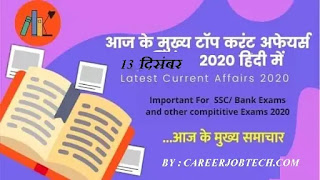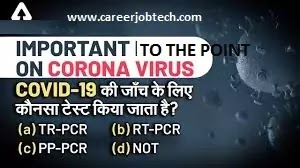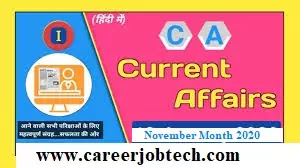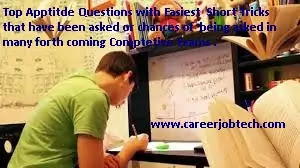Thursday, September 8, 2022
साईबर क्राईम से सुरक्षित कैसे रहें एवं साईबर क्राईम घटित हो जाने पर तत्काल की जाने वाली कार्यवाही की संंपूर्ण जानकारी
Tuesday, February 2, 2021
Latest Current Affairs 2021 For Bank(Current Affairs)/All Govt Competitive Exams, That may be Asked in Forthcoming Exams Part2 in 2021
Monday, December 21, 2020
बैंक , इंडियन रेलवे ,यू पी एस सी , ऍम पी पी एस सी ,आदि विभिन्न प्रतियोगिता परीक्षाओं की तैयारी के लिए महत्वपूर्ण टू द पॉइंट (करेंट अफेयर 2020) जानकारी जिससे सम्बंधित प्रश्न आने वाली प्रतियोगिता परीक्षाओं मे पूछे जा सकते हैं ।
बैंक , इंडियन रेलवे ,यू पी एस सी ,
ऍम पी पी एस सी ,आदि विभिन्न
प्रतियोगिता परीक्षाओं की तैयारी के
लिए महत्वपूर्ण टू द पॉइंट
(करेंट अफेयर 2020) जानकारी
जिससे सम्बंधित प्रश्न आने वाली
प्रतियोगिता परीक्षाओं मे पूछे जा
सकते हैं ।
1) लाकडाउन 4 को खत्म करके सरकार ने 01
जून को जो गाईड लाईन जारी की है उसका
नाम अनलॉक 01 है ।
2) चीन देश ने कोविड 19 के ईलाज में भालू
पित्त के उपयोग का सुझाव दिया है ।
3) आयुष कवच कोविड एप्प को उत्तर प्रदेश
राज्य ने लांच किया है ।
4) फीफा अंडर 17 महिला विश्व कप
(भारत में ) होने वाले को स्थगित कर
दिया गया है ।
5) लाकडाउन में आनलाईन सेवा वितरण
एप्प मी बडडी एप्प को लांच अरूणाचल
प्रदेश ने किया है ।
Wednesday, December 16, 2020
अयोध्या राम मंदिर ,कोरोना वायरस एवं अन्य महत्वपूर्ण विषयों से संबंधित टू द पाईंट जानकारी जिनसे संबंधित प्रश्न आगामी प्रतियोगिता परीक्षाओं में पूछे जा सकते हैं।
अयोध्या राम मंदिर ,कोरोना वायरस एवं
अन्य महत्वपूर्ण विषयों से संबंधित टू द
पाईंट जानकारी जिनसे संबंधित प्रश्न
आगामी प्रतियोगिता परीक्षाओं में पूछे
जा सकते हैं।

1) राम मंदिर की उचाई 161 फीट होगी ।
पहले 141 फीट थी अब 161 है ।
2) अयोध्या राम मंदिर का निर्माण एल
एन टी कंपनी करेगी ।
एल एन टी का फुल फार्म लार्सन एंड टुब्रो है।
3) अयोध्या राम मंदिर के वास्तुकार चन्द्रकांत
सोमपुरा है ।
4) अयोध्या उत्तर प्रदेश राज्य में स्थ्ति है ।
5) श्री राम जन्म भूमि के मंदिर का शिलान्यास
05 अगस्त 2020 को किया गया है ।
Sunday, December 13, 2020
बैंक , इंडियन रेलवे ,यू पी एस सी , ऍम पी पी एस सी ,आदि विभिन्न प्रतियोगिता परीक्षाओं की तैयारी के लिए महत्वपूर्ण टू द पॉइंट (करेंट अफेयर 2020) जानकारी जिससे सम्बंधित प्रश्न आने वाली प्रतियोगिता परीक्षाओं मे पूछे जा सकते हैं ।
बैंक , इंडियन रेलवे ,यू पी एस सी , ऍम पी
पी एस सी ,आदि विभिन्न प्रतियोगिता
परीक्षाओं की तैयारी के लिए
महत्वपूर्ण टू द पॉइंट (करेंट अफेयर 2020)
जानकारी जिससे सम्बंधित प्रश्न आने
वाली प्रतियोगिता परीक्षाओं मे पूछे जा
सकते हैं ।
1) त्वांग उत्सव अरुणाचल प्रदेश मे
शुरू हुआ है ।
2) संसई फेस्टिवल ,उत्सव मणिपुर मे मनाया जाता
है ।
3) गुजराती समुदाय ने दुनियाभर मे नववर्ष बेस्तु वर्ष मनाया
गया ।
4) जॉन अब्राहिम आंध्र प्रदेश के ब्रांड एम्बेसडर हैं ।
5) शक्ति संयुक्त सैन्य अभ्यास इंडिया और फ्रांस देश के मध्य हुआ है ।
Saturday, December 5, 2020
कोरोना वायरस से सम्बंधित महत्वपूर्ण टू द पॉइंट जानकारी जिससे सम्बंधित प्रश्न आने वाली प्रतियोगिता परीक्षाओं मे पूछे जा सकते हैं ।
महत्वपूर्ण टू द पॉइंट जानकारी
जिससे सम्बंधित प्रश्न आने वाली
प्रतियोगिता परीक्षाओं मे पूछे जा
सकते हैं ।
2 ) कोरोना वायरस का नाम लैटिन भाषा से
उतपन्न हुआ है ।
3 ) हाल ही मे कोरोना टेस्टिंग किट बनाने वाला देश का पहला शैछणिक संसथान आई आई टी
दिल्ली बन गया है ।
4 ) हाल ही मे राजनाथ सिंह ने देश की पहली मोबाइल लैब का उद्धघाटन किया है ।
Tuesday, December 1, 2020
विभिन्न प्रतियोगिता परीक्षाओं की तैयारी के लिए पूछे जा सकने वाले महत्व्पूर्ण टू द पाईंट करेंट अफेयर 2020 पार्ट 4
Friday, November 27, 2020
Top Aptitude Questions with Easiest Short Tricks that have been asked or chances of being asked in many forth coming Comptetive Exams .
Top Aptitude Questions with Easiest Short Tricks
that have been asked or chances of
being asked in many forth coming Comptetive Exams .
HCF : Highest Common Factor (Related )
Q : Find the greatest possible number by
which when we divide the numbers
38, 66 and 80 the remainders are same ?
Solution :
38
, 66, 80
First
Second Third
First Number – Second Number
Whichever is Greater among First Number and
Second Number
Wednesday, October 21, 2020
What is unemployment ? How the Crises of Unemployment can be solved In India in 2020?
What is unemployment? How the Crises of Unemployment can be solved In India in 2020 ?

Rising levels of the
unemployment have been brought into sharp focus by a sharp contraction of 23.9% in
India’s GDP in the First Quarter.
The Lockdown are likely
to result in the indian economy contracting
by over 10% in the full financial year.
Tuesday, September 22, 2020
Thursday, July 9, 2020
Wednesday, July 8, 2020
Friday, June 26, 2020
Thursday, June 25, 2020
General science MCQ with answers for competitive exams
A.) Refraction of light. B) The reflection of light. C) total internal reflection. D) The dispersion of light
Correct Answer → Option A
Q2 Hematite is an ore
A.) Aluminum. B) Iron. C ) Zinc. D) Wed
Correct Answer → Option B.
Q3 According to Arrhenius NaOH is a base because:
A.) It has a bitter taste. B) It can neutralize acids. C ) It bleeds red litmus paper.
D )It gives OH-ion in water
Correct Answer → Option D
Q4 Blood clotting occurs due to
A.) Fibrin. B) Thrombin. C) Thromboplastin. D ) all of the above
Correct Answer → Option D
Q5. Green plants make food
A.) Photo-oxidation b.) Photorespiration. C )Photosynthesis. D) photolysis
Correct Answer → Option C
Q6. The image made in the compound microscope is
A.) erectile inverted B) sometimes straight, C ) sometimes upside down. D) None
Correct Answer → Option B.
Q7. The lens used in a simple microscope is
A.) Concave. B) Convex C) Cylindrical D ) None
Correct Answer → Option B.
Q8. To eliminate toxic nitrogen wastes and excess water in humans
A. ) Emission ... B ) Circulation. C ) Reproduction D ) Pollution
Correct Answer → Option A
Q9. S. I. Unit of refractive index is
A. Meter. B. CMC. C watt .D no unit
Correct Answer → Option D
Q10. Liquid is metal
A ) Bismuth. B) Magnesium. C ) Mercury. D) Sodium
Correct Answer → Option C
Q11. Which of the following is not a primary color
A.) Red. B) Blue. C) Green .D Yellow
Correct Answer → Option D
Q12 Endothermic reactions are those in which
A ) heat is developed. B) The heat is absorbed. C ) temperature increases. D ) light is generated
Correct Answer → Option B.
Q13. What color of light is least distracted
A. ) Red. B). Blue.C ) Violet.D) Green
Q14. The acid present in gastric juice is
A.) Hydrochloric acid. B)-Citric acid. C) Sulfuric acid D) vinegar acid
Correct Answer → Option A
Q15. Which blood cells are called 'Soldiers' of the body
A.) W.B.S.B. B ) Platelets. C) RBC. D) all of the above
Correct Answer → Option A
Saturday, June 20, 2020
Use local resources career in school education Using local resources
Use local resources career in school education
Using local resources
Many teaching resources can be used for teaching - not just textbooks. If you use methods that use different senses (sight, hearing, touch, smell, taste),
you will attract different ways of learning for students.
There are resources all around you that you can use in the classroom, and that can help your students' learning.
Any school can develop self-learning resources at little or no cost.
Using these materials from the local environment, you can make connections between the curriculum and students' lives.
You will find people in your immediate environment who are well versed in a wide range of subjects; You will also find many types of natural resources.
This will allow you to connect with the local community, demonstrate its importance, encourage students to see the abundance and diversity of their environment,
possibly most importantly, a holistic approach to student learning - that is, within the school and It may help to work towards adopting outside education. Making the most of your class
People work hard to make their homes as attractive as possible.
It is also important to think about the environment where you expect your students to be educated.
Anything you can do to make your classroom and school an attractive place to study will have a positive impact on your students.
There is a lot you can do to make your classroom interesting and engaging - for example, you can:
Make posters from old magazines
and booklets
Using local resources
Can bring items and crafts related to the current topic
Display your students' work
Things
can change in the classroom to keep students curious and motivate students
towards new learning.
Using local experts in your classroom
If you are working on money or quantities in mathematics, you can invite market traders or entrants to the class and ask them to explain how they use mathematics in their work.
Alternatively, if you are working on a subject such as conventions and shapes under the subject of art, then you can invite mehndi designers to school to explain the different shapes, designs, traditions, and techniques.
Inviting guests is most useful when the relationship with educational goals is clear to each individual and shared expectations of timeliness exist.
You may have experts in the school community available (such as cooks or caretakers) who can be reflected or interviewed by students regarding their learning.
For example, to find out the quantities used in cooking, or how weather conditions affect school grounds or buildings.
Using
an external environment
Using
local resources career in
school
education
There are many resources available outside of your classroom that you can use in your lessons.
You can collect (or ask your class to collect) objects such as leaves, spiders, plants, insects, stones, or wood. Bringing these resources can lead to interesting classroom displays that can be used in lessons.
They may provide objects for discussion or experimentation, such as classification-related activity, or living or non-living objects.
Resources such as bus schedules or advertisements can also be readily available that may be relevant to your local community - these include education resources by setting tasks to identify words, compare qualities, or calculate travel times Can be changed.
Objects can be brought from outside into the classroom - but your classroom can also expand to the outside.
There is usually more room outside for all students to walk and see more easily. When you take your class outside to learn, they can do the following activities.
Estimating
and measuring distances
To
show that every point on the circle is at the same distance
from the central point
Recording the length of shadows at different times of the day , Reading hints and instructions
Conducting interviews and surveys












